If you have ever wondered what it would be like in a country with a history of more than 5,000 years? I believe this China escorted tours will give you a full understanding of China. In this 18-day escorted tours to China, we will visit the ancient capitals such as Beijing, Xi’an, and Chengdu, the cities with charming scenery such as Guilin, Lijiang, Dali, and Kunming, as well as the highly developed city such as Shanghai. I believe you will never want to leave these cities after visiting. In addition, if you are very interested in Chinese history, you can’t miss the best escorted tours to China. Because most of the attractions we will visit have a history of thousands of years! You can get a deeper understanding of China after visiting them. Join us for an 18-day escorted tours to China now!

Welcome to Beijing! After getting off the plane, follow the stream of people or indicators to the exit. And you will easily find your tour guide waiting for you at the arrival hall. Then our guide will escort you to the hotel. You can have a good rest in the hotel to get over the jet lag. Or you can walk around the Qianmen Street, where sits the Quanjude Roast Ruck Restaurant (the most famous Peking duck restaurant), where you can taste the authentic Peking duck.
After breakfast, we will go to visit Tian’anmen Square. Built in the Ming Dynasty(1368-1644), Tian’anmen (In Chinese, the word “men” means the gate) was the main gate of the imperial city(ancient Beijing) during the Ming and Qing (1636-1912) Dynasties. After the founding of the People’s Republic of China, the Chinese government built a square in front of Tian’anmen, which is Tian’anmen Square today. Tiananmen Square covers an area of 440,000 square meters, equivalent to 61 football fields. Nowadays, the square is an important place for Chinese people to celebrate festivals and important national celebrations.
After visiting Tian’anmen square, we will visit the Forbidden City (closed on Mondays). It was the imperial palace in the Ming and Qing Dynasties. It covers about 720,000 square meters, twice as large as the Moscow Kremlin. When coming to the Forbidden City, you may find a strange thing that no bird can be found on the roofs. The reason for it is that the roofs are all made of glazed tiles, which are very smooth. Besides, the roofs have a large angle, which makes it more difficult for birds to stand on them.
After lunch, we will move on to the next attraction - Temple of Heaven, where the emperor worshiped heaven in ancient times. One of the most striking buildings here is the Hall of Prayer for Good Harvest. Every spring, offerings such as cattle, sheep and pigs, as well as the wooden boards, on which the prayers and blessing words would be written, would be provided for the emperor to pray for a good harvest from the Chinese God. These offerings and wooden boards would be burned. The generated smoke rising into the sky implies that the emperor’s prayers and blessings would be taken to the Chinese God. In addition, to mark the 600th anniversary of the Temple of Heaven, there are many commemorative snacks, such as cakes and ice creams with the shape of the temple of Heaven. If you are tired from walking, you may as well taste this special delicacy.
After visiting the Temple of Heaven, we will go to the Summer Palace, the largest royal garden in Qing Dynasty(1636-1912). It was built on the basis of Kunming Lake and Longevity Hill. Besides, there are Long Corridor, Marble Boat, Bronze Ox, Seventeen-Arch Bridge, etc. in the Summer Palace. You can walk along the Kunming Lake to admire the beautiful scenery. In addition to walking, we will also arrange for you to take a boat to feel the charm of Summer Palace. After visiting the Summer Palace, your tour guide will escort you back to the hotel. Enjoy your second night in China!
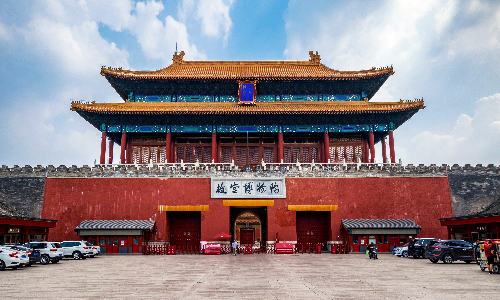
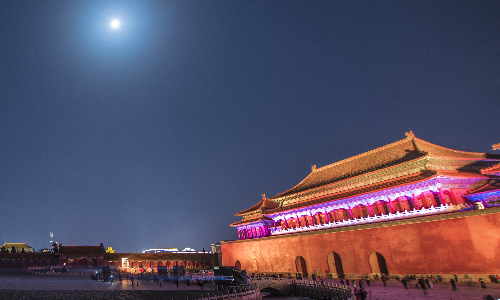
Today we are going to visit Ding Tomb. The tomb is 50 kilometers north of Beijing, and it takes about 70 minutes to get there. It is the tomb of the thirteenth emperor of Ming Dynasty. This tomb is the only one tomb that has been excavated of the Ming Tombs(tomb group where buried 13 emperors in Ming Dynasty ). In 1957, the Chinese archaeological team excavated the Ding Tomb, which brought great misfortune to Chinese archaeology. After the archaeologists opened the gate of this tomb, a lot of air rushed into it, and the cultural relics that have been sealed for hundreds of years were oxidized soon. A large number of colored cultural relics faded, furthermore, many kinds of silk and satin rotted, which caused huge loss. After that, the Chinese government has forbidden any archaeological teams to excavate these tombs.
After lunch, we will visit the Great Wall! We will head to one of its sections, as well as the most famous one, Mutianyu Great Wall. Mutianyu Great Wall is located at 40 kilometers northeast of the Ding Tomb, and it takes about 1 hour to get there. The Great Wall, with a history of more than 2,000 years, was a military defensive project in ancient times. Among the best Beijing attractions selected by the international authoritative tourism forum, the Mutianyu Great Wall is at the top of the list. You can take the cable car or chairlift to the highest section and enjoy the beauty around. After visiting the Great Wall, our guide will take you back to the hotel. Today is our last day in Beijing. Tomorrow we will go to the second Chinese city, Xi’an.
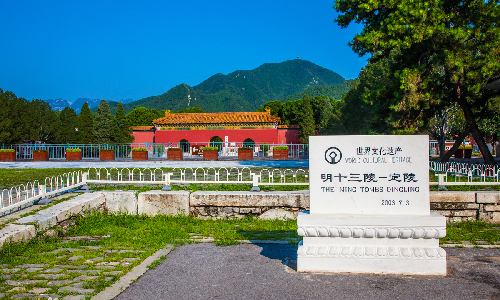
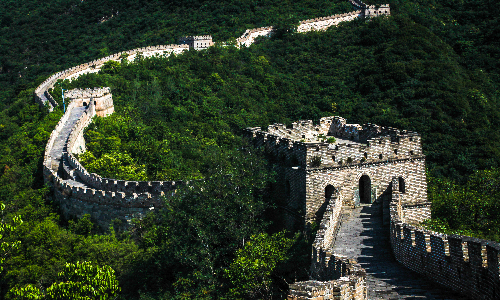
 Xi’an
Xi’an Today we will leave Beijing and take the estimated train G429 10:45/16:21 to Xi’an, where a tour guide will pick you up and escort you to the hotel. Because it is late afternoon when we get here, no attraction will be arranged for you.You can have a good rest in the hotel.
Free time Suggestion:
If you are not tired after your arrival, I highly recommend you to explore the Great Tang All Day Mall. It is a very popular pedestrian street with Tang culture as the background. And it is the first choice for visitors to experience the culture of glorious Tang Dynasty(618-907) in Xi’an. Besides, there are splendid musical fountain shows on the north square of this pedestrian street. It is the largest Asian musical fountain show. If you go to the Great Tang All Day Mall, you cannot miss this show.
As one of the four ancient capitals in the world, Xi’an is the capital of 13 dynasties. And Qin Shi Huang, the first emperor of China, ascended the throne here. Today we will drive east for about 40 minutes(40KM) to the Terra Cotta Warriors and Horses Museum. It was listed as a World Heritage site by UNESCO and known as the eighth wonder of the world. It has been visited by more than 200 foreign government leaders. The museum contains more than 8,000 terracotta warriors and horses (more are still buried in the ground). These terra cotta warriors and horses were all made under the proportions of real people and horses. What’s more, the most amazing thing is that all these terracotta warriors were sculptured with diffident cloth, figures, facials, and expressions. According to the record, there were more than a thousand artisans participating in the project. When you see these terracotta warriors, you may have a sense of looking at the real persons from ancient times. I am sure you will have a very special experience here.
After lunch, we will go to visit Big Wild Goose Pagoda. It was built under the leadership of monk Xuanzang to store the scriptures and Buddha statues he took back from India. You may be strange to the name of Xuanzang, but you may have heard Journey to the West, one of China’s four great classical novels. Actually, this book was written based on the stories of Xuanzang. The name of Big Wild Goose Pagoda came from a story. A long time ago, Buddhism was divided into Mahayana and Hinayana. Monks of Mahayana ate vegetarian food while those of Hinayana ate meat. One day, in a shabby pagoda, the monks found that there was nothing to eat. Looking at the wild gooses flying in the sky, one monk muttered to himself “We have nothing to eat. If only a goose would fall to the ground.” Suddenly, the leading goose fell to the ground and died, which amazed all the monks there. They all thought that the dead goose was a symbol that the Buddha was angry for what the monk said. Because in Buddhism, it is forbidden to kill living creatures. The monk realized that he had made a big mistake and he was very regretted. To express his faithfulness in Buddhism. He quit eating meat. Influenced by his behavior, the other monks also quit eating meat. Later, to commemorate this thing, people called this shabby pagoda “Big Wild Goose Pagoda”. When Xuanzang came back from India and decided to build a pagoda in ancient Xi’an, he also named this new-built pagoda “Big Wild Goose Pagoda” inspired by this story.
After touring the pagoda, we will head to the Xi’an Old City Wall, the largest and best-preserved ancient wall of China. Different from the Great Wall, Xi’an Old City Wall is wider, and the widest section of it can even allow 4 cars to pass side by side. When you walk on the wall, you may notice many red lanterns are hung along the gray wall, making it more colorful. And You can roam on the wall, enjoy the beauty of Xi’an. With the tall buildings as well as the ancient stone bricks in front of you, you may experience the perfect fusion of history and modernity. After visiting the Xi’an Old City Wall, our tour guide will take you back to the hotel.
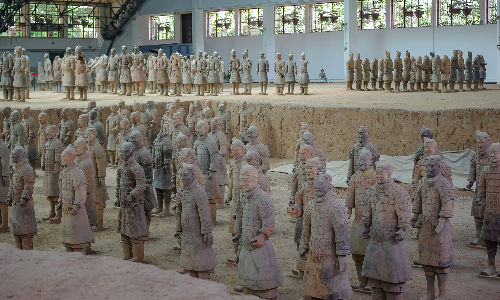
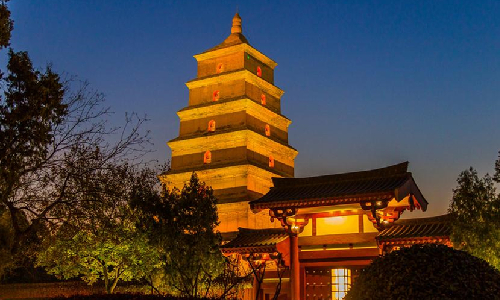
 Chengdu
Chengdu Today we will head to the third city, Chengdu. You will take the estimated flight MU6796 12:40/14:20 to get there. Our tour guide will pick you up and escort you to the hotel. You may have heard the famous Chinese hotpot. The hotpot in Chengdu is the most famous in China. I highly recommend you to taste the Chengdu hotpot. I’m sure you’ll love it.
Today we will head to Leshan Giant Buddha, one of the most famous attractions in Chengdu. Leshan Giant Buddha is located at 163 kilometers south of Chengdu, and it will take about 2 hours to get there by car. As the largest stone Buddha statue around the world, Leshan Giant Buddha was built in 713, and it takes more than 90 years to complete this masterpiece. It is said that in ancient times, the air currents here were very strong, and boats are easy to capsize when passing here. So, a monk, to stabilize the air currents, called on people to build a huge Buddha statue here(In Buddhism, the Buddha statue will turn bad into good). The Buddha is 71 meters tall and 20 meters wide, and only the buns on its head are more than 1,000. I am sure you will be amazed by this majestic Buddha statue.
On the way back to Chengdu, we will visit Huanglongxi Ancient Town, with a history of more than 1,700 years. After arrival, you can enjoy many traditional Chinese snacks. Among them, the most famous one is the longevity noodle. This kind of noodle is widely known in China. It is different from common noodles as it was just a single-strand long noodle in one bowl. Chinese people believe that eating longevity noodle implies living a long life. So, in some important time such as the birthday, longevity noodles are usually indispensable.
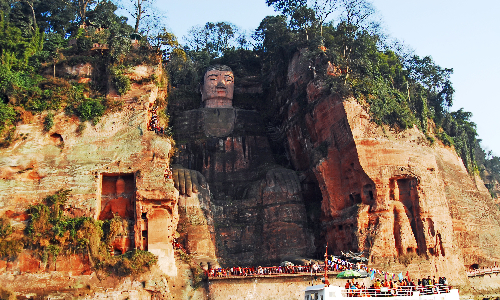
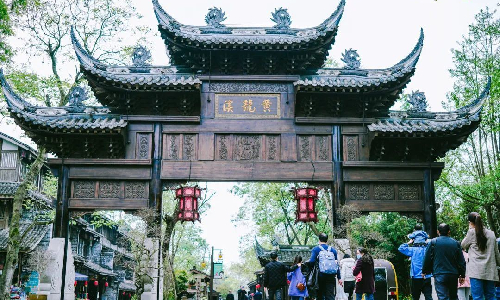
 Guilin
Guilin After breakfast, our tour guide will escort you to the train station, and you will take the estimated train G2963 09:49/15:07 to Guilin. Our tour guide will pick you up and drive you to the hotel. Guilin is famous for its mountains and rivers, and there is a Chinese saying, “Guilin’s landscape is the best in the world”. I believe you will be dazzled by the natural beauty of it! Today we have no arrangements, but you can use your nighttime to visit the East and West Lane. It is the only lane that can date back to Ming and Qing Dynasties in Guilin, and you can visit the ancient buildings here. Besides, there are many traditional Guilin foods such as Guilin rice noodles, Osmanthus cake, and Water chestnut cake. All of these are delicacies that you cannot miss!
After arriving in Guilin, we will visit the Reed Flute Cave first. Legend says that there used to be a king of reed, which can be made into flutes. That is the reason for the name of Reed Flute Cave. Over 1 million years ago, there used to be an ancient underground lake. For the crustal movement, the lake became a cave. And after a long period of chemical reaction, various kinds of stalactites were formed. Among all caves around the world, the Reed Flute Cave receives the largest visitors in number. Since its open, more than 40 million visitors have appreciated its beauty. Besides, many leaders have also been here. Mrs. Nixon praised the cave as “spectacular and magnificent, just like a palace.” In a message to Reed Flute Rock, the president of the Austrian Federal Parliament, Mrs. Hasselbach, wrote, “It is a fairy tale”. If you also want to experience the wonder of this place, you might as well come in person.
After visiting the Reed Flute Cave, we will head to the Sun and Moon Twin Pagodas. The Sun and Moon Twin Pagodas Park is the first Chinese cultural park with the theme of Confucianism, Buddhism, and Taoism. The landmark of this park is the Sun and Moon Pagoda. The splendid Sun pagoda, with a height of 41 meters, is decorated with copper. Inside the pagoda, there is a sightseeing elevator. The Moon pagoda, with a height of 35 meters, is decorated with colored glaze. Besides, there are 12 Chinese Zodiac statues as well as the corresponding patron saint statues. If you also want to know what your Chinese zodiac and patron saint is, you might as well come here to find it.
After lunch, we will head to the Elephant Trunk Hill. The hill got its name from its appearance, which looks like an elephant drinking water. It is also one of the symbols of Guilin. Legend says that there used to be seven fairies who went down from heaven to enjoy the beauty of the earth. While the youngest one found people at this area often suffered from flooding and took pity on them, so she secretly went to the earth with the Jade Emperor’s (The most powerful god in Chinese legend) legendary mount, an elephant, to help people dredge the river. However, the Jade Emperor found out and brought the fairy back to heaven. The Jade Emperor left the elephant here and turned it into a stone hill to punish it. Later, people named this hill “Elephant Trunk Hill”.
After visiting the famous Elephant Trunk Hill in Guilin, we will visit the lake here. We will visit the Ronghu Lake and Shanhu Lake. This attraction is located in the center of Guilin. With a bridge as the boundary, Shanhu Lake is in the east, and Ronghu Lake is in the west. And the two lakes are respectively named after the banyan(Rong represents banyan) and cedar trees(Shan represents cedar tree) growing on the lakeshore. Since the Qing Dynasty, wealthy gentry and celebrities have set up houses on the shore of the lake. Besides, it is an important cultural center of Guilin. If you also want to experience the local culture and history, visiting this place is a great choice. After visiting the two lakes, our tour for today is over, and your guide will take you back to your hotel.
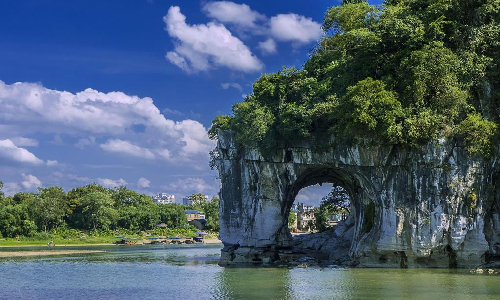
 Yangshuo
Yangshuo Guilin
Guilin Today we are going to the Mopanshan dock and board the ship to admire the gorgeous Li River scenery. Mopanshan dock is located at 35 kilometers southeast of Guilin, and it takes about 50 minutes by car. After arriving at the dock, we are going to have a four-hour Li River Cruise. On the cruise, you will notice an interesting mountain, where stands Wangfu Rock (In Chinese, the word “Wangfu” means a wife is waiting for her husband), which looks like a woman with a baby on her back, looking out into the distance. According to legend, in the Qing Dynasty, a family of three came here by boat, but there was only a small bucket of rice left, which is not enough for them to eat. The husband went out to find food, only to find nothing. Feeling anxious, he turned to a stone man. Later, the wife took their baby with her to find the man. After seeing her stone husband, the wife was so sad that she also turned to a stone.
Today we will have lunch on the ship, where you can enjoy the beautiful scenery on both sides of the Li River while eating. After four hours’ journey, we will arrive in Yangshuo. Yangshuo West Street, with a history of more than 1,400 years, is a pedestrian street as well as the oldest street in this county. Since the 1950s, nearly 40 government leaders have visited this place. And the former U.S. President Jimmy Carter and his wife also rode bicycles on West Street for sightseeing. In China, there is an old saying that food is the most important thing. When we come to this ancient street, of course, we cannot miss the delicious foods here. Beer fish is a famous specialty in Yangshuo, and the ingredients are very particular. The fish is spicy and delicious without any fishy taste. The fish are fresh Li River fish. The smell of beer and fish is sure to whet your appetite. After you have eaten and played well at Yangshuo West Street, we will drive northwest for about 1.5 hours(80KM) back to Guilin.
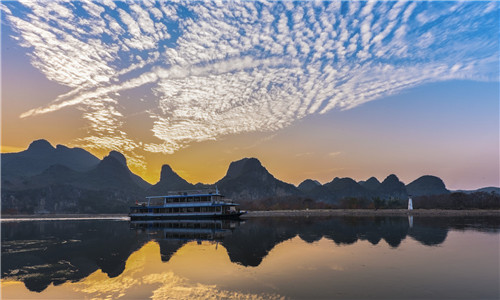
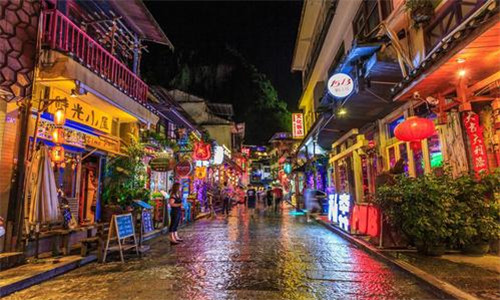
 Lijiang
Lijiang After breakfast, our tour guide will drive you to the airport, and you will take the estimated flight MF8635 10:40/12:35 to Lijiang. After picking you up here, your new tour guide will take you to visit the Lijiang Ancient Town. This town covers an area of 7.729 square kilometers and has a history of over 700 years. If you like taking pictures, you cannot miss the Youzhisan Street (Youzhisan is a traditional oil-paper umbrella with over 400 years of history) in this ancient town. Here, all kinds of oil-paper umbrellas are hung above the street. It is a perfect place to take beautiful and memorable photos. Most buildings here are of a long history, so when you are walking in the street, you may feel as if you were walking in the ancient China 700 years ago.

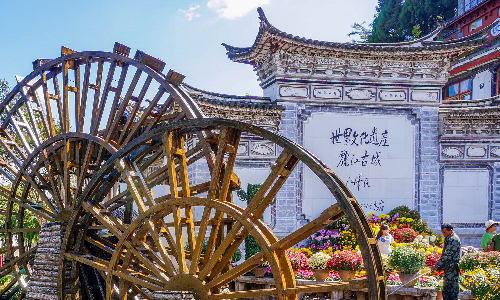
Today we are going to the most famous attraction in Lijiang, Jade Dragon Snow Mountain. The mountain is located at 21 kilometers north of Lijiang, and it takes about 40 minutes to get there by car. The Jade Dragon Snow Mountain is called “Oulu” in Naxi (the main ethnic minority in Lijiang) language, which means “the mountain of heaven”. And its 13 snow-capped peaks are endless, like a flying dragon. In the sunshine, the snowy peak tops look like crystal jade, so it is called Jade Dragon.
At the foot of Jade Dragon Snow Mountain, there is a beautiful valley, called “Blue Moon Valley”. The snow on the mountain melts and flows into this valley. When the moon is reflected in the lake, its reflection looks like the Blue Moon Valley in Disappearing Horizon, so it is called Blue Moon Valley.
After lunch, we will visit Baisha Village and see the Baisha murals there. As an ancient town with a history of more than a thousand years, Baisha was the first gathering place of the Naxi people in Lijiang. And the famous Baisha Murals is the embodiment of Naxi culture and art. The making of the whole Baisha Murals lasted for more than 300 years from the early Ming Dynasty to the early Qing Dynasty. These ancient murals reflect the history evolution of Naxi culture. Besides, I believe that if you visit these exquisite murals in person, you will be impressed by the superb drawing skills of these murals.
After appreciating the Baisha Murals, we will head to the Shuhe Ancient Town. The town is one of the earliest settlements of Naxi ancestors in Lijiang. And the most famous attraction in this ancient town is Qinglong Bridge. With a history of more than 400 years The bridge was built during the Wanli period(1573-1620) of the Ming Dynasty. The bridge is 25 meters long, 4.5 meters wide, and 4 meters high, all made of stones. The Qinglong Bridge has become mottled after hundreds of years of erosion by wind and rain. Besides, when you stand here, you can even imagine the scene that people and horses passed through it every day in the past time.
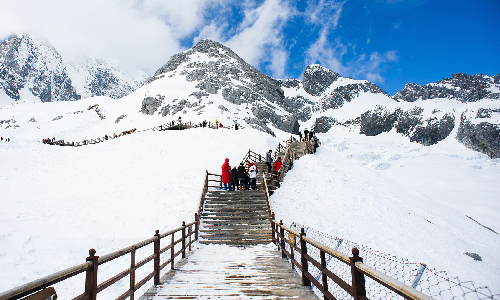
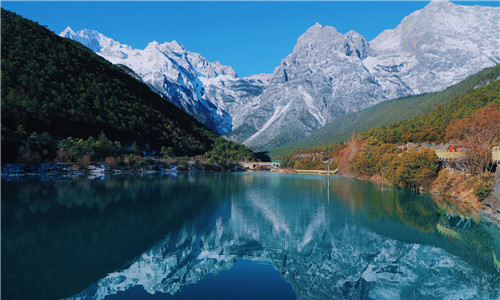
 Dali
Dali After breakfast, we will drive from Lijiang to Dali. Dali is located 176 kilometers south of Lijiang, and it takes about 2 hours to get there. After arriving in Dali, we will visit Dali Ancient Town first. As the political, economic, and cultural center of Yunnan (the province where Dali is located), it has a history of over 500 years. It covers an area of 3 square kilometers. In this ancient town, you can admire the quaint buildings, eat special local foods and buy some characteristic handicrafts.
In addition, we will also visit the Chongsheng Temple and the Three-pagoda. The attraction is located 1.5 kilometers northwest of Dali Ancient Town. And among the three pagodas, the most famous and largest one is the Qianxun Pagoda. The tower is 69.13 meters high, with 16 floors. While the other two towers are basically the same in structure and shape. Interestingly, the two towers are slightly tilted towards the Qianxun Tower. About the building of these three pagodas, there is a story. Legend has it that in ancient times, floods often attacked this place. People believed that building pagodas could suppress floods, so they built these three towers.
After lunch, we will head to the beautiful Erhai Lake. As the most famous attraction in Dali, the clear lake water looks like a mirror reflecting the blue sky. When you come to Erhai Lake, the most important thing that you cannot miss is to ride a bicycle along the lake. When you are feeling the breeze while cycling, looking at the blue sky and clear lake, you may be able to forget all the troubles in life. Besides, as one of the most beautiful places to take photos in China, every part of Erhai lake will show you a different charm. After visiting Erhai Lake, the tour guide will take you back to your hotel in Dali.

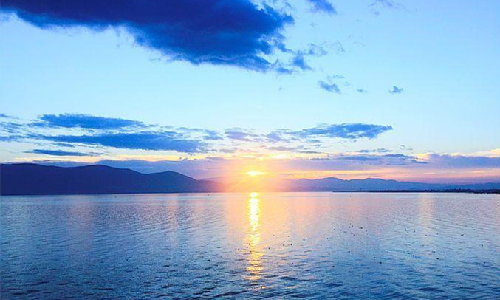
 Kunming
Kunming Today we are going to Kunming by car. Kunming is 340 kilometers east of Dali, and it will take about 4 hours by car. After arrival, you will have lunch first and then head to the Stone Forest. For us, the forest is not rare, but have you ever seen the forest composed of stones? About 300 million years ago, this place was a land of vast oceans. After a long period of geological evolution, extremely precious geological relics, which cover many types of karst landform on the earth, have finally been formed. Here, you can see all kinds of stones, as many as stars. In addition, the Stone Forest has been rated as a “World Geopark” by the UNESCO. After visiting the Stone Forest, the tour guide will escort you to your hotel in Kunming.
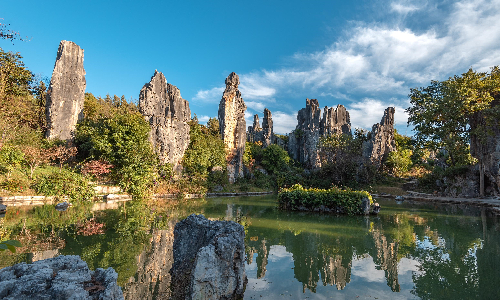
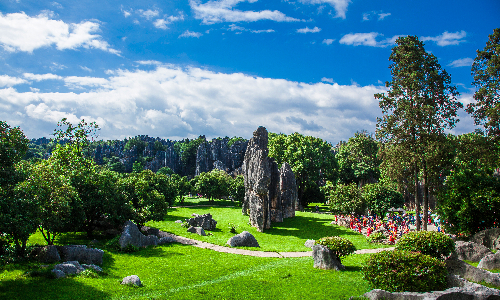
 Shanghai
Shanghai Today we will take the estimated flight CZ3678 12:25/15:25 to Shanghai. Our tour guide will pick you up at the airport and escort you to the hotel. Prepare to embrace your escorted tours in Shanghai!
After arriving in Shanghai, we will visit Jing’an Temple first. You might not expect Shanghai, one of the world’s top cities filled with skyscrapers, still have room for ancient architecture. Jing’an Temple is the oldest Buddhist temple in Shanghai and its history can be traced back to 247. Walking into the temple, you may notice the famous Yongquan Well. The well is 6 meters deep, and the wellhead is hexagonal, made of a whole piece of stone. The Yongquan Well was built with 666 pieces of granite, with its bottom rock alone weighing 6,000 kilograms.
After visiting Jing’an Temple, we will head to Yu Garden (closed on Mondays), a famous private garden in the past. It was built in the Ming Dynasty and has a history of more than 400 years. There are various pavilions, ponds, rockeries, bridges, etc. Just as what the locals said, “You will find a new scenery in each corner of Yu Garden.” When you are tired, you can find a place, wherever by the fish pond or under the willow tree, to sit down, admiring the fish or just enjoying a relaxing time for a while.
After lunch, we are going to explore modern Shanghai. The first place we’ll visit this afternoon is the Bund. Located along the Huangpu River, the Bund is the one of most famous attractions in Shanghai. You will see countless high-rise modern buildings gathering on the east bank of Huangpu River. And you will also see over 30 classical buildings of different styles standing at the west of the Bund. Such a splendid layout at this area makes the Bund known as the “World Architecture Expo”.
After visiting the Bund, we will go to the Nanjing Road. We will experience the most prosperous pedestrian street in Shanghai. There are many famous stores, hotels and restaurants and so on. Besides, there are also many famous Shanghai foods, such as smoked fish, meat-stuffed moon cakes, drunk snails, and drunk crabs, etc. Enjoy a relaxing time here!
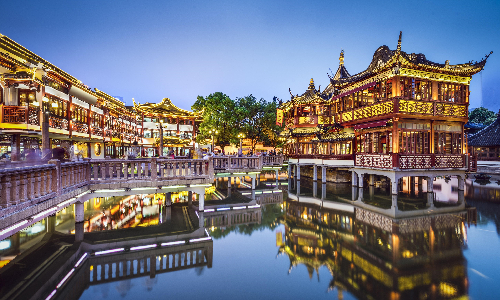
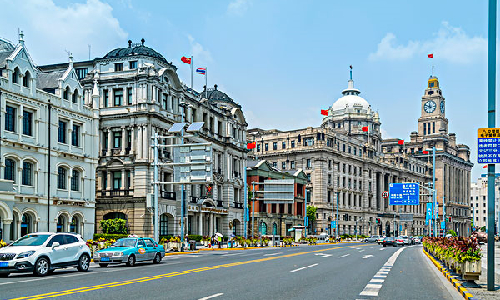
 Suzhou
Suzhou Shanghai
Shanghai Today we will start our escorted tour from Shanghai to Suzhou. Suzhou is located 100 kilometers west of Shanghai, and it takes about 2 hours to get there. After arriving in Suzhou, we visited Tiger Hill at first. The hill is located in the north of Suzhou, with a history of more than 2,500 years. The most famous attraction in Tiger hill is Jianchi (Jian means sword and chi means pond.). Jianchi can be said to be the most mysterious place in Tiger Hill. Legend has it that the tomb of Helü(The King of Wu State in the late Spring and Autumn Period, 770BC-476BC) is located nearby. The Jianchi is the burial pit of this tomb. The shape of this pit is like a pond. When Helü was alive, he ordered to make three thousands swords. And he told his ministers that after he died, these swords should be buried as the burial objects. Many years later, people found this burial pit. At that time, these swords were still in the pit. So people are used to calling it Jianchi.
After visiting Tiger Hill, we will head to Shantang Street, which was built along the Shantang River. It is 3,600 meter long. Most of the buildings here are of ancient style with gray tiles and white walls. Walking on this street will bring you a feeling of walking on the ancient street 100 years ago. The atmosphere here is different from that of modern cities and you can experience the most unsophisticated rural life.
After lunch, we will visit the famous gardens in Suzhou. Besides the scenery, Suzhou is also famous for its gardens. Of the four most famous gardens in China, two are in Suzhou, namely the Lingering Garden and the Humble Administrator’s Garden. Different from the imperial garden, Summer Palace, these two gardens were private gardens in the past. The layouts of the two gardens are more compact. When you walk in these two gardens, you may be surprised to find that there is always new scenery when you pass a corner or walk through a door. I believe you will fall in love with these two gardens as you stroll around and appreciate the stone bonsai as well as pavilions everywhere. After the tour, we will drive back to Shanghai.
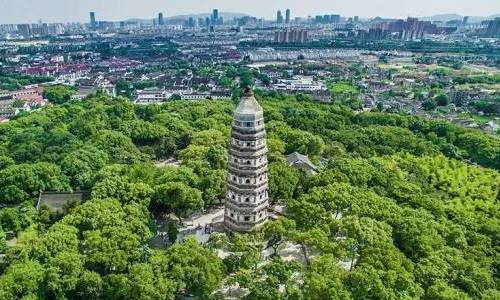

Our 18-day escorted tours to China are all over! Our guide will escort you to the airport according to your flight schedule. Look forward to your next China tour with us.
Author: Ziyang Zhang
Proofreader: Yan Liu
| City | Five Star hotel list | Four Star hotel list |
|---|---|---|
| Beijing | Sunworld Dynasty Hotel Beijing Wangfujing | Sunworld Hotel Wangfujing |
| Xi'an | Tianyu Gloria Grand Hotel Xi'an | Sunworld Dynasty Hotel |
| Chengdu | Sofitel Chengdu Taihe | Holiday Inn Express Chengdu Jinniu |
| Guilin | Lijiang Waterfall Hotel | Guilin Bravo Hotel |
| Lijiang | Wonderport International Hotel | Lijiang Wangfu Hotel |
| Dali | The One Hotels & Resorts | Landscape Hotel |
| Kunming | Grand Park Kunming | UChoice Hotel |
| Shanghai | Ocean Hotel Shanghai | Courtyard by Marriott Shanghai Central |
 |
![]() About your child or infant, please contact us for a discounted price.
About your child or infant, please contact us for a discounted price.



We started with a few days in Beijing & ended in Shanghai, from where we visited the Forbidden City and Great Wall. In between we visited Terra Cotta Warriors Museum, Panda Base, Shanghai Disneyland.

We had a wonderful holiday in China which will remain long in the memory. China is a breathtakingly beautiful country full of splendid temples and palaces, mountains and rivers, peaceful rural scenes and bustling shopping streets.
 QUICK ENQUIRY
QUICK ENQUIRY